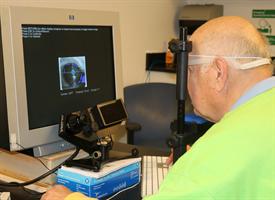New study details "physical therapy" for eyes

DeMay fixes his gaze on a live image of his own eye
in preparation for the next round of training.
Patients who went partially blind after suffering a stroke regained large swaths of rudimentary sight after undergoing visual training designed by researchers at the University of Rochester Medical Center's Flaum Eye Institute.
A new study out today in Neurology®, the medical journal of the American Academy of Neurology, provides the first evidence that rigorous visual training recovers basic vision in cortically blind patients with long-standing stroke damage in the primary visual cortex. Damage to this area of the brain prevents visual information from getting to other brain regions that help make sense of it, causing loss of sight in one-quarter to one-half of an individual's normal field of view. Somewhere between 250,000 and 500,000 people suffer vision loss due to damage to the visual cortex each year.
"We are the only people in the U.S. currently using this type of training to recover vision lost after damage to the primary visual cortex," said study senior author Krystel Huxlin, Ph.D., director of Research and James V. Aquavella, M.D. Professor of Ophthalmology at URMC's Flaum Eye Institute. "If you talk to the majority of clinicians, they still believe nothing can be done."